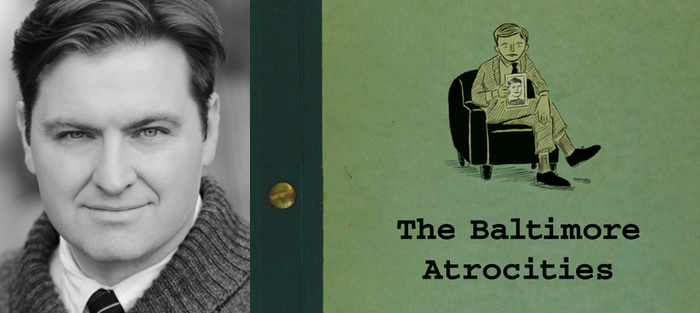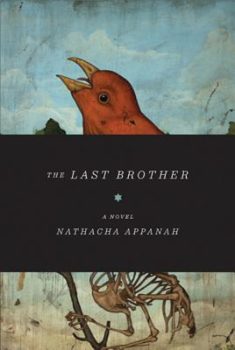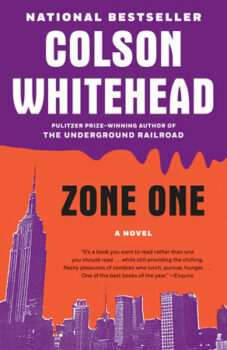I first met John Dermot Woods in 2003, when we were graduate students at The University of Georgia. We discovered quickly that we had friends in common from other chapters of our lives, overlap from high school and college, though we attended different schools in different states. For me, there was something immediately familiar about John, something that felt like home—both the place and the quality. It did not take long for me to learn the depth and breadth of his talent, which includes his ability to read widely, to collaborate compassionately, and, in terms of his own praxis, to build worlds, when language falls short, out of painstakingly drawn pictures.
To read John’s work—and there is a considerable body of it: The Baltimore Atrocities (Coffee House Press, 2014), Activities (Publishing Genius, 2013), The Complete Collection of people, places & things (BlazeVox, 2009)—is to know him in a similar way, to continuously adjust one’s eyes, one’s senses, to the prismatic glint of the recognizable and the strange. Deftly, through both visual images and text, he creates landscapes that feel like home even when they seem to portend danger. We are invited, as readers, to revisit the places we thought we knew, and to see in them features we’d previously, either out of will or out of habit, overlooked. Again and again, we are confronted with the question: has it changed, or have I?
In his most recent book, The Baltimore Atrocities, two men, Thomas and Barney, attempt to decode a catalog of mystifying and menacing events that took place in and around their home city, to glean from apocrypha and public record a sense of personal belonging. It is an origin story as we’ve never seen it, where the history and mythology of a place create the history and mythology of the individual, forming, as it does, a bricolage of heartbreak and deliverance.
INTERVIEW
Kristen Iskandrian: Let’s start at the very beginning. What made you first start writing? How old were you? What were your earliest inspirations?
John Dermot Woods: The very beginning is pretty late for me. I didn’t write any kind of fiction to speak of until I was out of college. I spent time painting and writing college journalism before I wrote stories. I think, though, once I was out of school for a while, and able to read without a restraint, I couldn’t help but want to reproduce this work I loved. I think I began writing as a way of imitating some combination of Flann O’Brien, David Foster Wallace, and Dostoevsky. I basically set myself up for disappointment from the beginning.
 I got to know you during our graduate school years in Athens, Georgia. I know you’ve spent time in Tokyo—I’ve always thought The Complete Collection was a sort of homage to that city. Here, we have Baltimore. Tell me about your fondness for that place, what it’s built upon. Is it your creative ground zero?
I got to know you during our graduate school years in Athens, Georgia. I know you’ve spent time in Tokyo—I’ve always thought The Complete Collection was a sort of homage to that city. Here, we have Baltimore. Tell me about your fondness for that place, what it’s built upon. Is it your creative ground zero?
Maybe. Baltimore is definitely the place where I started writing in earnest. So I think I trace this work that I’m still doing back to there. I’d agree that The Complete Collection, which was written mostly in Tokyo (and Athens between stints in Japan), is a reaction to that city. I think, though, The Baltimore Atrocities is more of a response to not being in a place, rather than my experience in Baltimore itself. It’s about absence and longing and the futile undertaking of trying to grasp the ephemeral. This book is more about the failure of memory to preserve past experiences than the experiences themselves.
What about you? Do you have a single physical place that you can identify as your creative starting point? Is it a city like Philadelphia or Athens? Or is it something smaller than that?
I love the idea that The Baltimore Atrocities is about a failure of memory, since memory is, it seems to me, an inherent failure. Isn’t it? We try to capture a thing, but know that we cannot, so instead, we create all of these proxies, begging them to fit, to be the thing we most need to remember. If I had to choose a creative starting point, I’d say it has something very much to do with memory, with recording. As soon as I learned to write, I kept a diary. My diaries were more or less the most boring things in the world, but I guarded them fiercely. I wrote every detail of my day before I went to sleep at night, and it became a compulsion—on some level, I was afraid of what would happen if I missed a day. I guess I was afraid of forgetting—forgetting what I’d had for lunch or what Mr. Flocco said during music class. If I forgot, then maybe I would disappear. Not that I was conscious, of course, of these terrifyingly high stakes.
I also love how personal this work feels, even as it announces itself as a kind of archived reportage. Even if you say this book isn’t about Baltimore, it is called The Baltimore Atrocities. Can you talk a little about your own relationship with Baltimore? Like, why Baltimore?
Baltimore, in the case of this book, is more of a word than a city. It’s a name that defines the site of where something happened. Baltimore means a lot of things to people who aren’t from there: Cal Ripken, The Wire, drugs, the Inner Harbor, Edgar Allen Poe, urban blight, Johns Hopkins, and John Waters. But I wasn’t interested in any of those things specifically when I wrote The Baltimore Atrocities. Instead, Baltimore was a place that represented loss. A real place that lingers just beyond the tangible. I wanted my characters to return to an actual city, a city my reader could believe (to cite Baltimore’s one-word urban renewal campaign), but I wanted that city to be a ghost that enveloped them. For my characters, Thomas and Barney, Baltimore is a looming presence in their lives, especially before they actually move there. Baltimore is an idea that has to be addressed and ultimately resolved.
When I lived in Baltimore, I was there to study fiction writing at the Johns Hopkins Writing Seminars, and it’s where I wrote my first serious stories and my first novel. It’s where I met my first real writing mentor in Stephen Dixon. It’s where I met my wife. In some way, the ghost of Baltimore haunts all my writing, as it’s where it began. But I left Baltimore a decade ago, so its presence in my life is ephemeral. The Baltimore in The Atrocities is more of a palimpsest than a rendered place. It also became a useful tool in grounding my characters’ exploits. The history and geography of the city allowed me to flesh out the logistics of their story.
I have always been amazed and inspired by your productivity; I’ve always known you to be working on multiple things at once. When your narrator says that he feels like “a fool who had given up everything to complete an impossible errand,” I had two thoughts: first, what a beautiful expression of the creative life; and second, what did Woods give up to complete this book? Did you push other things aside and devote your working time entirely to it? Or did it come in waves and cycles? Can you talk a bit about your process?
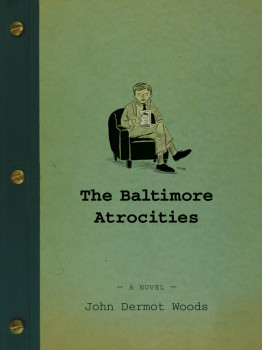 I wish I could say I put it all aside to get this done, but my life, like most, and my consistent dilettantism, meant that this book developed slowly as the result of occasional bursts of dedication, beginning with a semester’s worth of Long Island Railroad trips during which I wrote the first draft of the 100 or so atrocities. Teaching four classes a semester at a college an hour away from my house means I have to be pretty efficient with my time. Early on, I made a choice that instead of using my eight train rides a week to grade papers, I would use this time to read and write. The train rides would be my monastic moments. I ride the train in the middle of the day from the city where I live out to the suburbs, so the car is just about always empty. It’s a remarkably peaceful environment. One semester I set a goal of writing a draft of each of these episodes on the way to work, and thumbnail sketching a drawing to complete the story on the way home. By the end of the semester I had the first draft of the book.
I wish I could say I put it all aside to get this done, but my life, like most, and my consistent dilettantism, meant that this book developed slowly as the result of occasional bursts of dedication, beginning with a semester’s worth of Long Island Railroad trips during which I wrote the first draft of the 100 or so atrocities. Teaching four classes a semester at a college an hour away from my house means I have to be pretty efficient with my time. Early on, I made a choice that instead of using my eight train rides a week to grade papers, I would use this time to read and write. The train rides would be my monastic moments. I ride the train in the middle of the day from the city where I live out to the suburbs, so the car is just about always empty. It’s a remarkably peaceful environment. One semester I set a goal of writing a draft of each of these episodes on the way to work, and thumbnail sketching a drawing to complete the story on the way home. By the end of the semester I had the first draft of the book.
Amazing. I love this notion of the monastic moment, and how you equate it with your creative work—more ecstasy, for you, than agony, it would seem. And I love that this book was literally born in the arc between your home life and your professional/academic life. You’re putting that Amtrak residency to shame!
Oh, man, would I love an Amtrak residency. There’s nowhere better to write than on a moving train. It disconnects you from space. So, when writing on the train, I tried to create a disconnected world: no laptop, and my smartphone tucked deep in my backpack. I think I actually started this project right around the time I got an iphone, and I became afraid it would threaten the solace of my train trips (available email, texts, an endless stream of news about the failures of the New York Mets, etc.) On the train, I write in a notebook, usually a tightly ruled chemistry notebook with light green pages, the first of which was given to me by our mutual buddy Sabrina Orah Mark [author of the poetry collections The Babies (2004) and Tsim Tsum (2009), among other work]. I use a fountain pen. I’m precious with my writing.
My drawing, not so much. On the train, I draw loosely with a rollerball pen or whatever I have on the back of used printer pages or on index cards. I always redraw these at my drawing table in a more permanent way. In the case of The Baltimore Atrocities, I used brush and nib pen on Bristol board, old school cartooning tools. I’m a stiff artist, so the looseness of those first thumbnails is really important to get life and movement into my work.
The agony versus ecstasy point you make is interesting, and, somehow, something I’ve never considered. I do not find writing painful. And, I read about and hear about so many people who do. And, when I hear this, I feel guilty, as if I’m not serious or I’m not trying hard enough. Recently, though, I’ve realized that the process of writing isn’t agonizing for me (nor is it ecstatic), because I’m generally an anxious person. When I write, I assume that anxiety is still there, but I’m not paying attention to it. Writing distracts me.
In total, it took a few years to write and draw the 100 or so atrocities, and then I basically wrote the more conventional novelistic portion in about a month. I felt the need to bring this project to a close and that was the only way I could see to do it. I wrote that part during my sabbatical, mostly sitting outside at the Brooklyn Botanic Gardens. (I also remember the summer during which I did most of these drawings was hot as hell. So every time I look at my original art I think of my arm sticking to the table and the pages as I tried to ink these drawings.)
Creatively, what I have sacrificed is technical mastery. Splitting my time and training between two disciplines, even two that go together as naturally as writing and drawing, has made it difficult for me to refine my skill to anywhere close to where I want it. As such, writing stories, and especially drawing pictures, are consistently labored processes for me.
I think that’s a really good thing. God save us from stories or pictures that are simply “refined”! I find your skill formidable, but that’s not what I love best about your work. It’s the searchingness of it, and the friction between painstaking detail and atmospheric rumblings. It’s like a gathering of weather. Along those lines, what comes first for you, image or text?
I have yet to find a way not to reinvent the wheel every time I start a new project, which is exhausting. So the order in which I create my words and my pictures is different with each project. In the case of The Baltimore Atrocities, it was words and then pictures and then words. I began by writing a draft of all of the atrocious episodes, and, as I did so, it seemed only natural that each would include an image. So I drew them. And as I did this, it occurred to me that the story of the men observing these atrocities was suggested but not yet told. So, finally, I wrote that story.
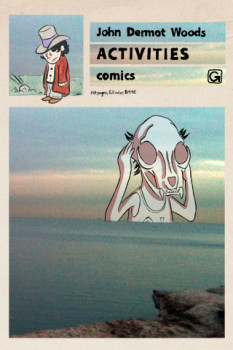 As you and I have discussed before, I have a real aversion to the word “illustration.” It implies redundancy and subservience. It suggests that a picture repeat what has already been written and that the image act in service of the text, rather than carry equitable narrative weight. And it encourages the prejudice against the visual that still exists. (And if you don’t think this prejudice exists, consider the way authorial credit is given for a book, and the way artists are compensated for their contributions to books. And, as someone who writes and draws, I can tell you that from an hourly labor standpoint, there is no question about which job is more intensive.) So, with this book, as with all my work, I very clearly did not want to “illustrate” my stories. I wanted to draw pictures that would extend the stories, further complicate them, contribute an essential narrative element that the stories could not exist without.
As you and I have discussed before, I have a real aversion to the word “illustration.” It implies redundancy and subservience. It suggests that a picture repeat what has already been written and that the image act in service of the text, rather than carry equitable narrative weight. And it encourages the prejudice against the visual that still exists. (And if you don’t think this prejudice exists, consider the way authorial credit is given for a book, and the way artists are compensated for their contributions to books. And, as someone who writes and draws, I can tell you that from an hourly labor standpoint, there is no question about which job is more intensive.) So, with this book, as with all my work, I very clearly did not want to “illustrate” my stories. I wanted to draw pictures that would extend the stories, further complicate them, contribute an essential narrative element that the stories could not exist without.
Were there any books that helped you write this one, either by giving you courage or ideas, or by getting you into a certain mood?
Thomas Bernhard’s The Voice Imitator planted the seed for this book. His episodes in that book offered me the narrative model for my own. Two novels by Kazuo Ishiguro, The Unconsoled and When We Were Orphans, presented an unstable sense of intrigue and mystery that I also hoped to capture. Ishiguro’s books are both mysteries in a very typical sense, but their resolutions confound the form altogether, breaking his narratives wide open. W.G. Sebald’s language, his use of image as narrative (both verbal and visual), and quietness also provided a guide.
I will always be grateful to you for introducing me, years ago, to Bernhard’s work. I will have to add those Ishiguro books to my list. And Sebald—yes—I think your work evinces a similar aura. What about the “factoid elements” of your book? What sort of research did you do? Are any of the accounts here historically accurate, even semi-so? Somehow you manage to strike this very interesting voice that seems half-folklore, half-journalistic.
I studied literary form, the form of reportage, more than research into any particular historical news items. The atrocities were written flatly and factually with the consideration that that form induces trust in the reader. It creates a faith that these incidents indeed happened as told. Unadorned prose suggests to the reader a lack of embellishment, even when the text is complete embellishment. Restraint engenders trust. I wanted to invoke the faith that we have in the “objective” reporter. Although each episode is a fabrication, I hoped that its surface would have the look of “just-the-facts.” To prepare, I looked at a few journalism texts, reviewed “the inverted pyramid,” consulted with my wife who is a former Wall Street Journal reporter, and read The Voice Imitator a lot. The narrator of the short episodes in that book creates this surprisingly uncanny effect with a voice that is completely flat and affectless. How Bernhard was able to do this became a problem I wanted to solve. The Baltimore Atrocities started as an experiment in figuring this out.
I love this sentence: “Those who have lost something important, like a mother or a father, or a brother or a sister, before they have a sense of themselves, must face maturity as seekers, constantly distracted by glimpses of things that are lost, with the hope that those things might be recovered.” I think it perfectly describes the pulse of the book—loss, discovery, recovery—and I love the idea of hope as busywork, or some kind of reckless distraction—like your attitude toward your writing. What is it that these characters gain, ultimately?
That’s a question I’m afraid to answer. Or, maybe, I’m just not able to answer. If I could answer it, I think that it would suggest a failure of mystery within the book. The book is about pursuit, not discovery. And I think that’s a pretty accurate description of our experience. We are always chasing things, but once they’re “found,” then they’re behind us, dead, fleeting, and, once again, beyond our grasp. In this book, Thomas and Barney are looking for what they already had.
Do you think they gain something? (It’s hard to understand your own characters, like it’s hard to understand your own mother.)
I think you put it very well. I would say, to put it in banal terms, Thomas and Barney gain a certain understanding, however meager, of their relationship to their pasts, to each other, and to the city. More poetically, it seems what they gain is loss—which none of us, however much we hate it, can live without.
In a way, Thomas and Barney have it all to begin with. They have a clear mission, defined at a very young age, a mission that they can pursue into adulthood. They have a passion, or a distraction, whatever you prefer to call it, to dictate their days. As the novel progresses, they lose more than they gain. As they mature and gain “perspective,” it becomes more and more difficult for them to stay dedicated to the very undertaking that has defined their entire lives. This is something I came to understand as I wrote their story. We find narrative structure recurring over time and place because there is something inherent and natural to certain structures. As my novel’s story came to its natural end, so did the ambitions and drives of my characters. I kept writing until their desires no longer had any fuel, or their ambition lost its target. People are not achievement-driven, they’re driven by pursuit. Whenever we reach a goal, something dies.
I mentioned your The Complete Collection of people, places & things earlier, a book I dearly love. That book is about collecting, and the idea that a collection is only alive when it is incomplete. The Baltimore Atrocities is a collection of a completely different sort. Talk to me about this affinity you have for collecting, collections, collectibles. What does it mean to you?
It’s an instinct that I become less comfortable with as I get older and raise children. The collecting instinct, which can result in beauty (Joseph Cornell and baseball cards), is also probably the single biggest cause of infrastructural instability in our world right now. It’s clearly a response to our economic structure that needs growth and constant consumption just to survive. And, as I raise children, and fill a house with crap, I get scared. Now my favorite pastime is throwing things away. Yet these things, these objects we share, do carry something. They are mediums that connect people.
Kristen, you’ve always seemed like somebody who appreciates objects. Since I’ve known you, you’ve had wonderful little things, and your homes, and your other spaces, always seem precisely arranged with these things. It’s like you orchestrate your surroundings. Is this something that gives you solace and peace? Do you ever suffer “stuff” anxiety?
Oh, do I ever. I pine for objects—sometimes being in the presence of beautiful things actually physically hurts me. But I am becoming more and more ascetic. Like you, I fear the clutter of child-crap. When my children bring home their art projects from school, I curate them immediately—the cookie cutter stuff gets trashed (while they sleep), the revelatory creations get hung and eventually filed, and I’m painfully aware of the thickness of that file. Once or twice a year I go through and weed it out. I am surprised by how unsentimental I am in this regard. Gradually, and probably as a result of having moved several times over the last few years, I find myself more exhilarated by throwing things away, and by exercising more restraint in terms of what I acquire. My mother is a serious collector of stuff. My father would live in one room with one change of clothes if he could. Growing up I always identified more with my mom’s tender amassing and sorting. These days, I feel a seismic push toward my dad’s sensibility.
What’s next for John Dermot Woods?
I’m trying to figure that out exactly. During the years I worked on The Baltimore Atrocities, my focus definitely moved from prose to comics. But, in finishing the novel, my desire to write stories came back to me. So, I’m writing another novel. It seems like it’s going to be a family book, the story of the end one family’s diaspora, an account of them all returning home to New York. I’ve got a few other things going. Lincoln Michel and I continue to chip away at our Herzog, Park Ranger graphic novel (which I spent the whole spring drawing), and I’ve begun collaborating with my friend Matt Laiosa, who is an incredibly talented comics artist, on a graphic mini-series about a boy and his long-lost dad as they run from the law. It’s called Harold and Harry, and it’s somewhere between K-Mart realism and From the Mixed-up Files of Mrs. Basil E. Frankweiler.
Oh, my goodness. From the Mixed up Files… is one of my all-time favorites. I’m excited to hear that you’re brewing something set in New York—in light of our chat about place, that feels very right. And along with the rest of America, I remain deeply enthralled by the Herzog project.
Well, it might be a while. Drawing comics takes forever. A graphic novel takes half a lifetime to create, and fifteen minutes to read cover-to-cover.
Editor’s Note: Check out “5 Cats,” an animated comic by Kristen Iskandrian and John Dermot Woods.

